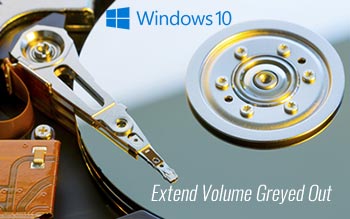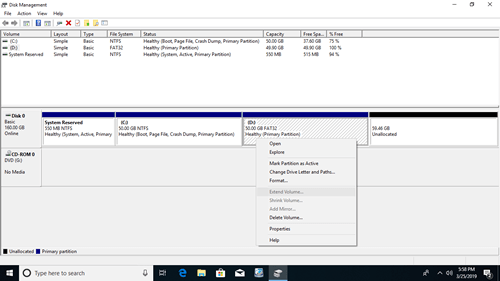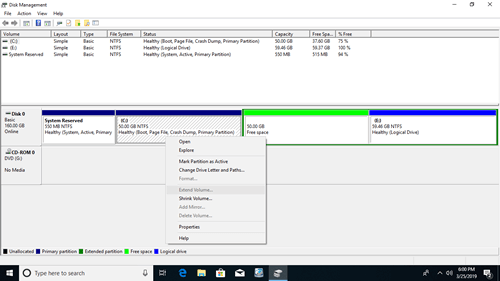From Windows 7, Microsoft added new "Shrink Volume" and "Extend Volume" functions in native Disk Management to help resize partition without losing data (in most cases). However, both functions only work under specific conditions. Windows 8/10 inherited the same functions without any improvement, so many people feedback that Extend Volume is disabled in Windows 10 and they cannot extend partition. This article introduces the reasons why Extend Volume greyed out in Windows 10/8/7 Disk Management and how to solve this problem easily.

Why is Extend Volume greyed out in Windows 10 Disk Management
Reason 1: No adjacent unallocated space on the right
As the name, "unallocated" space is kind of disk space that is not allocated to any partition. In Windows XP Disk Management, unallocated space can only be used to create new partition, but in Windows 10/8/7, it can be used to expand other drive.
Note: the size of a physical SSD/HDD is fixed, a 256GB disk cannot be decreased to 128GB or increased to 512GB. Before extending a partition, there must be unallocated space on the same disk. You can get unallocated space by deleting or shrinking other volume. It is better to shrink partition, because you won't lose files in it. Many people successfully shrunk D drive and get unallocated space, but Extend Volume is till grayed out.
Then why extend C: drive greyed out in Windows 10 Disk Management after shrinking D? From Microsoft explanation, "Extend Volume" function only works when there is adjacent unallocated space on the right. When you shrink D drive with Disk Management, unallocated space can only be made on the right of D: drive. Therefore, Disk Management cannot extend C drive with this nonadjacent unallocated space.
To show you the truth, I shrunk D: drive with Disk Management in my Windows 10 laptop.
As you see in the screenshot:
- Extend Volume greyed out for C drive, because the unallocated space is nonadjacent to it.
- Extend Volume is also disabled for E drive, because unallocated space is on its left side.
- Only drive D meets the requirement, so Extend Volume is activated.
No right adjacent unallocated space is the most common reason why Extend Volume greyed out in Windows 10/8/7 Disk Management.
Reason 2: File System is not supported
Another common reason why Extend Volume greyed out in Windows 10/8/7 Disk Management is related to file system.
Both Shrink and Extend Volume functions only support NTFS file system, FAT32 and any other types of partitions cannot be resized via Disk Management. To show you the truth, I formatted drive D from NTFS to FAT32. As you see, Extend Volume is grayed out for D drive.
In general, the system partition is formatted with NTFS by default when installing Windows, so this issue is just common for data partition.
If you initialized your hard disk as MBR, there could be 2 additional reasons why Extend Volume is grayed out in Windows 10/8/7 Disk Management.
Reason 3: Different partition type
Disk Management cannot extend a volume after shrinking another one, some people are wondering if it's possible to enable Extend Volume option by deleting the adjacent D: drive. It works on GPT disk, but on MBR disk, it depends.
Don't delete D drive if you installed programs or any services in it.
As you see in my computer, Extend Volume is still disabled for C drive after deleting D.
Then why Extend Volume is greyed out in Windows 10/8/7 even after I deleting the contiguous partition on the right?

On GPT disk, you can create many partitions and all are Primary, but on MBR disk, you can only create maximum 4 partitions if they are all Primary. Because there are only 4 entries in Master Boot Record, from which Operating System can locate the position of each partition.
To create more than 4 partitions, 1 of the entry must be assigned to the Extended partition. Extended partition works like a container and all Logical drives must be created inside of it.
Unlike Primary partition whose disk space will be converted to unallocated after deleting, disk space of a Logical partition will be converted to "Free" after deleting. Free space is still a part of the Extended Partition, so it cannot be combined to any Primary partitions.
Likewise, unallocated space that deleted from a Primary partition cannot be extended to any Logical drive via Windows Disk Management.
Reason 4: 2TB restriction on MBR disk
Another major limitation of MBR style disk is that you can only create maximum 2TB partition on it. If you initialize a 4TB hard disk as MBR, you can only use 2TB space, the remaining space will be shown as unallocated. When you right click this unallocated space in Disk Management, all options are grayed out.
As you see in the screenshot, F: drive is NTFS and there's contiguous unallocated space on the right, but Extend Volume is still grayed out in Windows 10 Disk Management.
What to do when Extend Volume is disabled in Windows 10/8/7
Method 1: Move unallocated space
When Extend Volume greyed out for C drive in Windows 10 after shrinking D or other volume, you must move unallocated space next to C drive in advance.
How to fix extend C drive greyed out in Windows 10/8/7:
- Download NIUBI Partition Editor, right click D: drive and select "Resize/Move Volume", drag the middle of D drive towards right in the pop-up window, then unallocated space will be moved to the left side.
- Right click C: drive and select "Resize/Move Volume" again, drag right border towards right in the pop-up window, then unallocated space will be combined to C: drive.
- Click Apply on top left to confirm and execute.
Follow the steps in the video:
To another contiguous data volume E, you can merge unallocated space to it directly without moving. To do this, right click E and select "Resize/Move Volume", drag left border towards left in the pop-up window.

Method 2: Resize volume with partition editor
If Windows 10 "Extend Volume" greyed out because you try to extend a FAT32 partition or the type of partitions that you want to shrink and extend are different, resize with NIUBI Partition Editor. There's no difference while resizing NTFS or FAT32 partition, Primary or Logical partition. Follow the steps in the video:
Method 3: Convert MBR to GPT before expanding
If you want to extend a partition past 2TB, follow the steps in the video to convert MBR disk to GPT and then you can extend partition with unallocated space.
In Summary:
Because Windows 10/8/7 Disk Management has many restrictions, you may encounter many problem while shrinking and extending partition. This article introduces the common reasons why Extend Volume greyed out in Windows 10/8/7 Disk Management and how to solve this problem with ease. Follow the corresponding solution according to your own disk partition configuration.
Besides shrinking, extending and moving partitions, NIUBI Partition Editor helps you do many other operations such as merge, convert, defrag, hide, wipe partition and scan bad sectors. It has free edition for Windows 11/10/8/7/Vista/XP home computer users.





